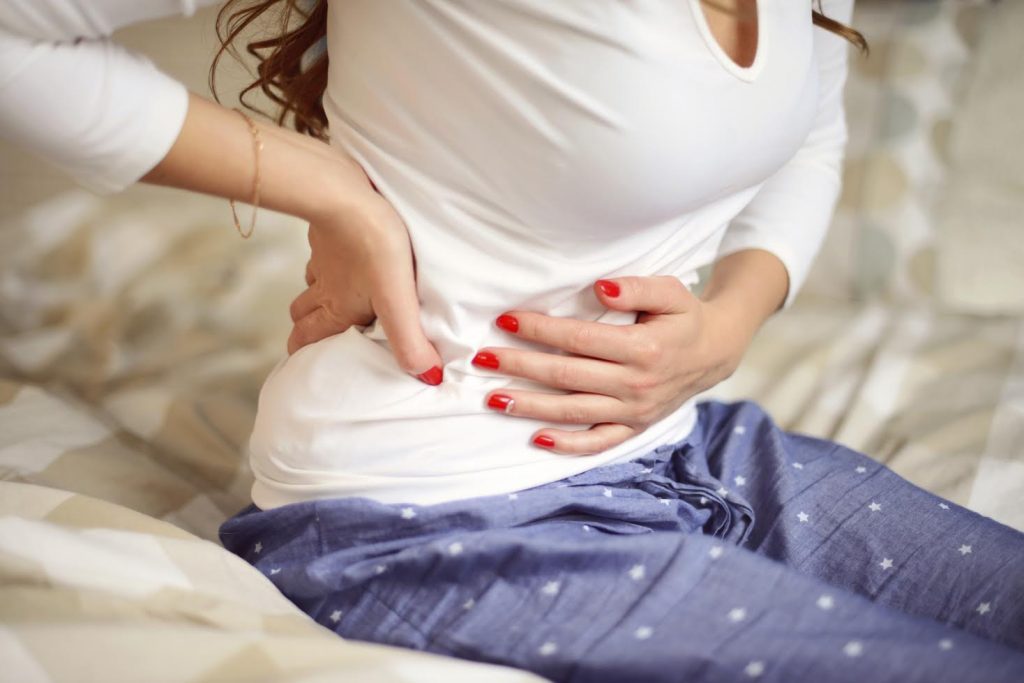
Bowel Endometriosis Treatment Los Angeles & Newport Beach, CA
The Center for Endometriosis & Fertility in Los Angeles & Newport Beach, California
What is Bowel Endometriosis
Bowel endometriosis is a form of endometriosis where tissue similar to the uterine tissue lining grows on the inside of the intestines or other structures within the abdomen. This endometrial-like tissue acts similarly to the uterine lining, bleeding and causing inflammation that worsens cyclically with menstruation. Unlike menstrual blood from the reproductive organs, which exits the body, the bleeding from bowel endometriosis occurs within the abdominal cavity or into the bowel itself. A small amount of blood is broken down and absorbed by the body, and this is a significant source of the inflammation and irritation that causes pain and bowel dysfunction. Bowel endometriosis can lead to serious complications like bowel obstruction and chronic pain if left untreated, and also often impacts fertility. Determining the exact prevalence of bowel endometriosis in the U.S. is challenging, but it’s estimated that around 3 – 37% of women with endometriosis have bowel involvement. This wide range reflects the variation in how studies define and diagnose bowel endometriosis. Many cases likely go undiagnosed due to how it mimics other digestive conditions and has far less awareness as compared to pelvic endometriosis. Many women with bowel endometriosis have their symptoms dismissed as IBS (Irritable Bowel Syndrome) or other bowel disorders, leading to underdiagnosis.
The Location of Endometriosis Within the Bowel
Research has determined that 90% of bowel endometriosis cases involve the large intestine (colon), especially the sigmoid colon (the S-shaped final portion of the colon, before the rectum) and rectum (the very last section of the large intestine). Less frequently, but it can also involve the small intestine, particularly the last portion (ileum) closest to the large intestine, appendix, and surrounding areas. Some women have lesions scattered throughout sections of the small intestine. Endometriosis can cause abnormal tissue growth on the external surface of the bowel, infiltrate deeply into the muscular layers of the intestine itself, or invade adjacent structures like ligaments supporting the bowel. In sporadic cases, endometriosis can even be found in the upper digestive tract (stomach, esophagus) or respiratory system.
The specific location of bowel endometriosis matters because it influences the type of pain and digestive problems experienced. For example, rectum-associated endometriosis tends to cause pain during bowel movements and potential bleeding. Also, the location of bowel endometriosis helps to determine which imaging tests (ultrasounds, MRI) or procedures (colonoscopy) are most useful for accurate diagnosis. Lastly, endometriosis lesions in certain areas of the bowel may require more complex robotic assisted surgery and expertise of a team that also involves a colorectal surgeon.
Complications of Bowel Endometriosis
While treatable, bowel endometriosis can lead to a range of complications, some potentially quite severe. Bowel endometriosis inflicts its damage on surrounding healthy tissue and causes a wide range of disruptive symptoms. Similar to endometrial tissue inside the uterus, endometriosis implants on the bowels respond to hormonal changes and painful periods along with intense inflammation. That inflammation, in turn, irritates the bowel wall and the network of nerves traversing the intestines, producing many of the painful symptoms. Abdominal pain is the hallmark of bowel endometriosis, often cyclical and worsening around menstruation, and can range from light cramping to sharp and persistent pain
Endometriosis tissue often deeply infiltrates the bowel wall, growing inward into the muscle layers. This can distort the normal structure and disrupt how the bowels contract to move stool. The body’s attempts to self-heal to alleviate pain can lead to intestinal fibrosis (an excessive accumulation of scar tissue in the intestinal wall), which can create stiffness and further disrupt the bowel’s normal functions. The disrupted bowel movements can cause stool to either move too slowly (constipation) or too quickly (diarrhea), sometimes alternating between the two. Impaired movement of gas and stool contributes to bloating and a feeling of uncomfortable abdominal fullness. Especially likely to occur during menstruation, as the inflamed lesions bleed within the bowel. In severe cases, bowel dysfunction can trigger nausea and vomiting.
Severe complications can arise from bowel endometriosis and lead to the development of fistulas or abnormal connections between two organs or structures. The chronic inflammation caused by endometriosis can weaken and break down the bowel wall and surrounding tissues, creating an ulcer-like defect. This can happen with the:
- Bladder: A Fistula forms between the bowel and bladder.
- Vagina: Fistula forms between the bowel and vagina.
As a result, bowel contents (gas or stool) can pass through the fistula and into the connected organ, increasing the risk of recurrent infections, pain, unusual discharge, urinary changes, and more. Also, while less common, endometriosis can cause narrowing of a bowel segment or total blockage. This prevents stool from passing and is a medical emergency.
Bowel Endometriosis Symptoms
It’s important to remember that there’s no single “typical” presentation of bowel endometriosis, and symptoms can vary significantly in their intensity and combination. Primary symptoms are deep pelvic pain, pain during sex, and painful bowel movements accompanied by sharp cramping or a feeling of intense pressure. The pain can be debilitating and surge with menstruation. Some women have a sense of uncomfortable fullness, pressure or bloating in the abdomen, even when not needing to experience a bowel movement. Bowel movements themselves can become irregular and accompanied by constipation (difficulty passing stool), diarrhea (loose and frequent stools) or an alternating pattern of both. Rectal bleeding is possible, particularly with menstruation and can range from bright red spotting to darker blood mixed within the stool. In more severe bowel endometriosis cases, an upset digestive system can lead to nausea and even vomiting.
Because bowel endometriosis symptoms closely mimic digestive or gastrointestinal pain, to the point where even professional physicians often mistake it for irritable bowel syndrome (IBS). The difference between bowel endometriosis and IBS is in the frequency and severity of pain. Women with IBS or other gastrointestinal conditions tend to experience pain multiple times during a week over a month, whereas the intense pain of bowel endometriosis very frequently surges and subsides with the menstrual cycle.
Some women have severe symptoms with minimal endometriosis, while others may have few issues despite extensive disease. Women experience bowel endometriosis symptoms in a variety of ways, including having no symptoms, other than their fertility being affected. If you experience any of these symptoms, particularly if they follow a cyclical pattern with menstruation, further investigation is sensible and warranted.
How is Bowel Endometriosis Diagnosed?
Diagnosing bowel endometriosis requires a multifaceted approach starting with a comprehensive review of your medical history and current symptoms, medications and health conditions. Initially, it’s important to rule out other possible conditions and identify any cyclical patterns of worsening bowel symptoms (pain, constipation, diarrhea, bloating) accompanying menstruation. A physical exam will involve pain mapping or pinpointing where the pain is located and its specific characteristics (sharp, crampy, etc.), which helps guide further investigation. I may check for tenderness or palpable nodules that might provide clues, but they can be normal even with bowel endometriosis.
Transvaginal/Transrectal Ultrasound can detect larger bowel endometriosis lesions, but standard ultrasounds miss many cases; thus, a more specialized MRI of the pelvis may be warranted. While not foolproof, an MRI of the pelvis with rectal contrast can be a helpful tool in detecting some cases of bowel endometriosis. In such a scenario, a special contrast material (often a gel) is carefully inserted into the rectum. This fills the lower part of the colon, outlining its shape and making the bowel wall easier to evaluate on MRI images. These images are most helpful when deep endometriosis is suspected and can sometimes show the location and approximate size of bowel endometriosis implants, particularly larger ones. It can also provide clues about whether the endometriosis is superficial (on the surface) or deeply infiltrating the bowel wall. For example, if endometriosis causes narrowing or tethering of the bowel, this may be visible on the MRI. If symptoms strongly suggest bowel involvement, MRI helps plan a surgical approach, map out the extent of endometriosis in multiple areas of the pelvis alongside the bowel and helps visualize other pelvic problems that might mimic bowel endometriosis symptoms.
However, MRI is a diagnostic tool rather than a definitive answer, can miss smaller lesions or those in specific locations within the bowel and doesn’t replace direct visualization. Biopsy (tissue removal) during colonoscopy or surgery is often still needed for confirmation of bowel endometriosis. Colonoscopy allows for direct visual inspection of the inside of the colon and biopsies of any suspicious areas. At the same time, primarily a surgical procedure, during a laparoscopy focused on endometriosis excision, direct visualization of bowel involvement is important for diagnosis and treatment as well. If any suspicious lesions are found during colonoscopy or laparoscopy, taking a tissue sample (biopsy) and having it analyzed by a pathologist is required for confirmation of bowel endometriosis.
Best Bowel Endometriosis Treatment Los Angeles
Endometriosis is commonly treated with a combination of excision surgery and hormonal therapies to alleviate symptoms and improve quality of life. Minimally invasive laparoscopy is often used for excision surgery, allowing specialists to remove endometriosis lesions with less recovery time and fewer complications. While hormonal therapies can help control pain and slow disease progression, they do not eliminate the lesions. Together, these approaches aim to both manage symptoms and address the underlying disease.
Hormone Therapy
A bowel endometriosis specialist takes the help of a multifaceted approach to achieve both symptom control and disease removal. Birth control pills, progestin-only options (pills, IUD, injections), or GnRH (gonadotropin-releasing hormone) can help reduce inflammation but will not cause resolution of the lesions. While these hormonal medications provide pain relief and may improve bowel function, they usually suppress endometriosis and don’t eliminate it entirely. Thus, medication may be considered after surgery to reduce the risk of recurrence.
Laparoscopic Surgery
Laparoscopic surgical excision is the gold standard for the treatment of bowel endometriosis, offering the best chance of long-term improvement of pain and range of bowel endometriosis symptoms. The complexity of surgical excision can vary from simple removal of surface lesions to more extensive procedures involving bowel resection (removing a segment of bowel) followed by reconnection.
Bowel resection is required in cases when:
- endometriosis grows deeply into the muscular layers of the bowel wall or;
- pain, bowel dysfunction (constipation, obstruction), bleeding are significant and unresponsive to other treatments or;
- complications like bowel fistulas (abnormal connections) or near-complete blockage exist.
More involved endometriosis surgery often requires a surgical team and carries higher risks of complications than simpler endometriosis excision procedures. We create the best treatment plan for bowel endometriosis treatment Los Angeles, tailored to treat endometriosis and its symptoms to ensure your overall well-being. Let me know if you’d like a more detailed explanation of the specific surgical techniques used to manage endometriosis of the bowel or if you want to explore options for a personalized treatment plan that suits your current medical condition.
Frequently Asked Questions
What is bowel endometriosis?
Bowel endometriosis occurs when endometrial-like tissue grows on or within the bowel, causing pain and digestive issues.
How is bowel endometriosis diagnosed?
Bowel endometriosis is diagnosed through symptom review, pelvic exams, imaging tests like ultrasound or MRI, and confirmed with laparoscopic surgery.
Is bowel endometriosis serious?
Yes, bowel endometriosis can be serious, as it may lead to chronic pain, digestive issues, and infertility.
Can bowel endometriosis cause infertility?
Yes, it can impact fertility due to scarring and adhesions in the pelvic area.
What happens if bowel endometriosis is left untreated?
If bowel endometriosis is not treated, it can lead to chronic pain, bowel obstruction, worsening digestive issues, and potential fertility problems,and the lesions may continue to grow and complicate the issue over time.
Dr. Sadikah Behbehani is in an OBGYN who specializes in Reproductive Endocrinology and Infertility as well as Minimally Invasive Gynecologic Surgery. She completed her 5 year OBGYN Residency at the well renowned McGill University in Montreal, Canada. She then completed a 2 year fellowship in Reproductive Endocrinology and Infertility (REI) at McGill University which makes her double board certified by the Royal College of Physicians & Surgeons of Canada in both OBGYN and REI. In addition, Dr. Behbehani completed a second fellowship in Minimally Invasive Gynecologic Surgery at the prestigious Mayo Clinic and can perform complex pelvic surgeries with both laparoscopy and robotics.
There are only a handful of physicians in the country with such training and being double fellowship trained in surgery and infertility allows Dr. Behbehani to treat complex gynecologic conditions affecting fertility such as endometriosis and fibroids.

Dr. Behbehani is very passionate about providing the best care to her patients, and she’s able to use her robotic skills and her fertility expertise to remove advanced endometriosis from the pelvis while still maintaining the integrity of the reproductive organs allowing them the best chances of pregnancy. With fibroid removal, Dr. Behbehani is able to skillfully remove large fibroids robotically, and expertly restore the anatomy of the uterus to reduce the chance of scar formation and improve pregnancy chances. Dr. Behbehani is also a mother herself, and feels passionate about helping patients start or grow their families. She is skilled in IVF and fertility treatment and has helped many patients become parents over the years.
As an Associate Professor at the University of California, Riverside School of Medicine, Dr. Behbehani is also heavily involved in medical research and publications. She’s presented at numerous national and international conferences, and her research is consistently quoted in women’s health. She’s a member of many international and national gynecologic societies including American Society of Reproductive Medicine (ASRM), American Association of Gynecological Laparoscopists (AAGL), and the Society of Gynecologic Surgeons (SGS). Click here for an overview of publications involving Dr. Sadikah Behbehani.
(949) 200-9038
1901 Newport Blvd, Suite 278 Costa Mesa, CA 92627
